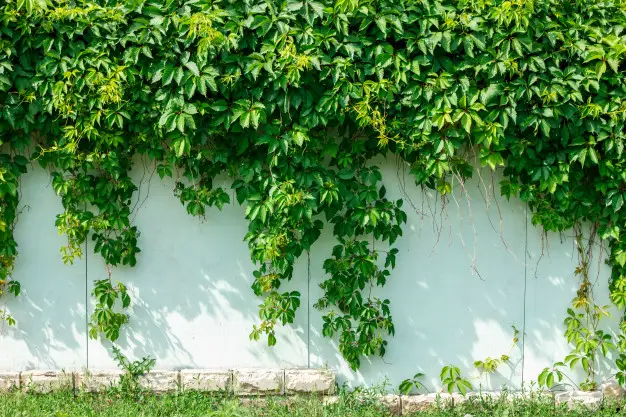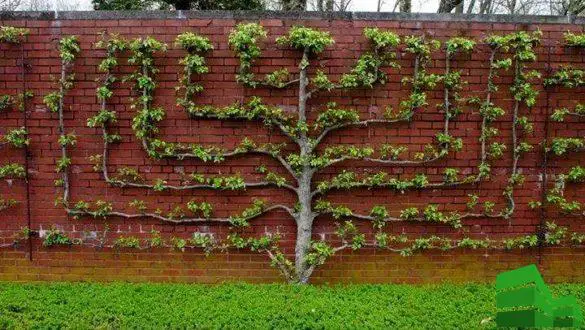Fences on plots and homes are built in various ways, using different materials: wood, brick. However, even the most beautiful fence can be simply made even better by adding the best ivy plants for fence. The most prominent representative of the plant world is ivy. Due to its excellent external qualities, it perfectly complements even forged structures, which at first glance look great initially. House with indoor plants look beautiful and eye attractive.
It is very easy to form a hedge using ivy. The growth rate is striking, although, in order for the plantation to grow beautiful, healthy, it is necessary to follow the planting technology and properly care for it.

Is Ivy good for fence?
All plantings that are directly related to garden plantings must form a single garden ensemble. Garden ivy is an ornamental plant that has a number of undeniable advantages:
- Creates a green wall that perfectly sets off areas of the garden. You can plant it along the fence, or create special frames for it so that the ivy thus independently weaves into the wall. In its appearance, properties a little resemble decorative climbing grapes, however, it has slightly more delicate leaves, root system.
- Adds aesthetics to any building. Due to its incredible tenderness, the delicate interweaving of branches, leaves, it will decorate the roughest wooden fence, make delicate jewelry forging even more delicate.
- Perfectly pruning. Thus, you can always correct the shape, as well as direct new shoots in the right direction. Few garden plants are also easy to handle.
- If there are ugly buildings on the site, for example, unsightly wooden gazebos, you can always cover them with ivy. Also, perfect if you need to hide something from the prying eyes of neighbors because the branches are so tightly intertwined that they form a solid monolithic wall.
- Surprisingly, such a delicate plant is evergreen. If you organize the right care, it will delight its owners all year round, it will perfectly preserve its decorative properties.
- Large financial investments will not be required for disembarkation. Saplings are inexpensive, require little attention, and are unpretentious to the soil. For many years ivy was considered a weed plant due to its potential for ubiquitous growth, but today it is considered an ornamental garden species, widely used in landscape design.
Take a look at Best Low Maintenance Hanging Plants.
What is the best ivy to grow on fence?
There are enough species for garden planting, due to the wide geography of the habitat. Some grow completely apart, wild, perfectly adapting to any type of soil, some are most popular in regions of a temperate climatic zone, there are subspecies most often used in the design of garden plots.
- An ordinary variety is distinguished by its versatility. The color of the leaves is slightly silvery, which makes the main gamut of the green wall light green with a steel sheen. Leaves come in different shapes, and directly within the same plant. If you look closely, you can distinguish between ordinary ellipsoidal leaves, slightly elongated, rounded at the base of the leaf, and the most beautiful, common ones in the form of a heart.
- Colchis ivy is incredibly common among gardeners due to its rapid growth. It has very large leaves, larger than that of a common variety, so it is an ideal option if you need to braid any area in the shortest possible time. The main thing is to competently prepare the landing site, to provide proper care.
Both varieties bloom, although bloom does not represent much of aesthetic delight. Berries, which by the way are inedible, give a much more interesting look to the plant.
The poisonousness of ivy is widely known. However, you can easily protect yourself from the poisonous juice. To avoid allergic skin reactions, it is enough to use closed clothing, special gloves while working with hedges.
You may also like best indoor plants for decoration.
Ivy fence planting technology
Ivy beautifully decorates alpine slides, playgrounds, gives coziness to garden patios, perfectly complements fences, serves as an excellent background for flowers, and plays an important role in multi-tiered landings. The main thing is to organize a competent disembarkation, systemic care.
- Reproduction occurs by cuttings, layering, ready-made seedlings. If you have nowhere to take them yourself, you should contact special nurseries. You need to choose especially carefully, because weak plants may not take root in a new place. Particular attention is paid to the leaves, roots. Their appearance is important, they must be dense, have a characteristic fresh color, the leaves must be juicy.
- Saplings take root well in any corner of the garden, tolerate heat, tolerate frosty weather well. However, it is much better to plant them in slightly shaded areas, avoiding the sun, which can negatively affect vital signs.
- The common ivies were brought from places with fertile soils and a humid climate. It is, of course, very difficult to create a tropical environment in the middle lane, therefore the plant will be very grateful to constant, systematic watering and soil fertilization. Although in general, the seedlings are unassuming, they are accepted in almost any soil. You need to understand that garden plots have an individual microclimate, depending on the already growing plantings, and the nature of the soil is always different. Therefore, like any plant, vines need additional feeding.
- Some plants prefer isolated planting, but ivy gets along well with some species. If it is not possible to distribute only it around the site, or there is a desire to diversify the plant world of the hedge, maiden grapes are often planted on the plantations. The two species interact perfectly, love the same soil, and remain green all year round.
- It is better to plant seedlings between the end of April and the end of May. For individual hedges, a special frame is built. It is necessary if the plant will stand apart, without complementing the finished buildings. Special supports are dug in, which will hold the entire structure. It is better to dig in deeper immediately if they are wooden at least 80 centimeters. Additionally, it is better to process the tree that is in the ground. Next, the immediate landing sites are marked. They dig holes at a distance of 50 centimeters, so the shoots will not interfere with each other, the distance is quite enough for weaving the shoots. The depth of the holes should completely interfere with the roots of the seedlings, avoiding folds. The soil inside the hole is thoroughly loosened, a little fertilized with peat, rotted humus. After closing the holes with the earth, you need to shed the holes thoroughly.
- Further, the plant develops quickly enough. The first summer season will give so many shoots that, with a modern garter of new branches, it will braid the entire space of the fabricated frame.
- The material of the supports is exclusively the choice of the gardener. The plant itself takes root completely to any: wood, metal, even plastic. The netting, which is pulled between the metal posts, is very suitable.
Ivy hedge care details
Free-growing ivy is more like a weed, a little clumpy in shape, the leaves are brighter, the appearance is a little sloppy. A lush, dense, green fence will turn out if you provide proper care.
- Regular watering is especially important in the early days after planting. Then the schedule is reduced, leaving it a couple of times a week in the summer, a little less often in the winter.
- Newly formed shoots are tied up, directing growth in the right direction, otherwise, they will be knocked out. Unnecessary, crooked growing, it is better to cut off.
- Fertilizer is optional, but vines look more attractive, the roots of which are flavored with special compounds. Such plantings can be distinguished even visually. They are more saturated in color, go up much faster, have an attractive steel sheen, dense leaves. Experienced gardeners advise fertilizing in spring (May), summer (August).
- You can get new seedlings in the fall by cuttings. Also, during this period, regrown shoots are pruned, dry branches are completely removed.
- It is better to cover young plants of the first year of growth with foliage, you can use burlap. The type of insulation is the root, it is unnecessary to close the entire liana.
See also Indoor Plants For North Facing Window.

how to grow ivy on a fence?
In the spring, it is possible in the summer, cuttings are cut, because it is with them that ivy reproduces best. It is better to leave the adventitious roots, with them growth will go much faster. Each cutting should be more than 10 centimeters long.
You can strengthen the roots in water, soil. Subsequent disembarkation plays an important role. It is carried out in the soil prepared in advance, loosened, watered well, flavored with fertilizers, mulch after planting, finely chopped tree bark can be used as mulch.
Liana herself tells the gardener when to change the care system. If the roots are oversaturated with moisture, the leaves turn yellow, then it is better to change the irrigation system. It is also often exposed to attacks of harmful insects, such as scale insects, thrips, spider mites. If you find light dots on the outside of the leaf, small cobwebs, it is necessary to spray the liana well first with water, then with special solutions against parasites.
